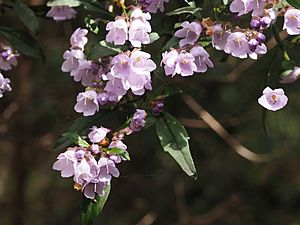Prostanthera lanceolata facts for kids
Quick facts for kids Prostanthera lanceolata |
|
|---|---|
 |
|
| In Sherwood Nature Reserve | |
| Scientific classification | |
| Genus: |
Prostanthera
|
| Species: |
lanceolata
|
 |
|
Prostanthera lanceolata is a species of flowering plant in the family Lamiaceae and is endemic to near-coastal area of eastern Australia. It is an erect, aromatic shrub that has stems that are square in cross-section, glandular, egg-shaped leaves and mauve or deep bluish-purple flowers.
Description
Prostanthera lanceolata is an erect, aromatic shrub that typically grows to a height of 3–4 m (9.8–13.1 ft) and has branches that are square in cross-section. The leaves are mid to dark green, paler below, narrow egg-shaped to egg-shaped, 15–25 mm (0.59–0.98 in) long and 9–12 mm (0.35–0.47 in) wide on a petiole 2–5 mm (0.079–0.197 in) long. The flowers are arranged in bunches near the ends of branchlets with bracteoles about 1 mm (0.039 in) long at the base, but that fall off as the flower develops. The sepals are about 4 mm (0.16 in) long, forming a tube about 2 mm (0.079 in) long with two lobes, the upper lobe 1.5–2 mm (0.059–0.079 in) long. The petals are mauve to deep bluish-purple and 8–12 mm (0.31–0.47 in) long. Flowering occurs in spring. This species is included in Prostanthera ovalifolia in Queensland.
Taxonomy
Prostanthera lanceolata was first formally described in 1928 by Karel Domin in Bibliotheca Botanica from material he collected near the "Tambourine Mountains" in 1910.
Distribution and habitat
This mintbush grows in forest in near-coastal areas of New South Wales and Queensland.

